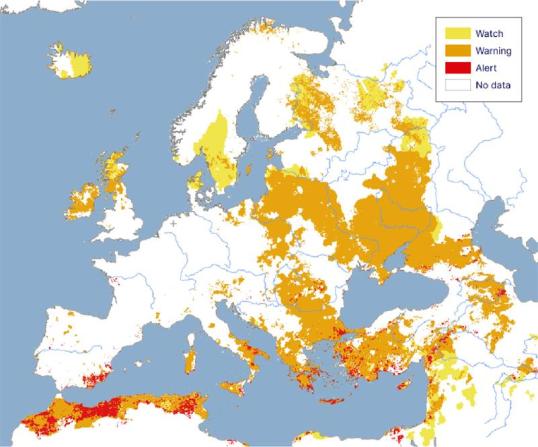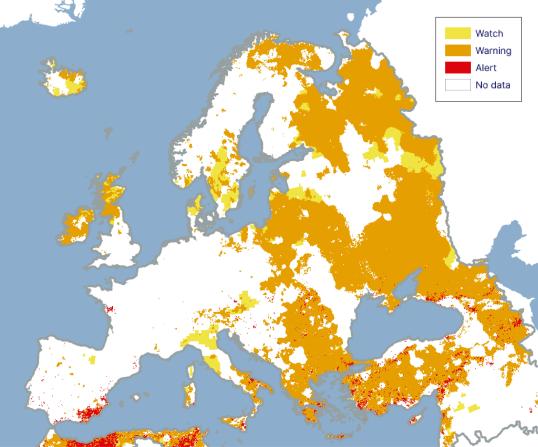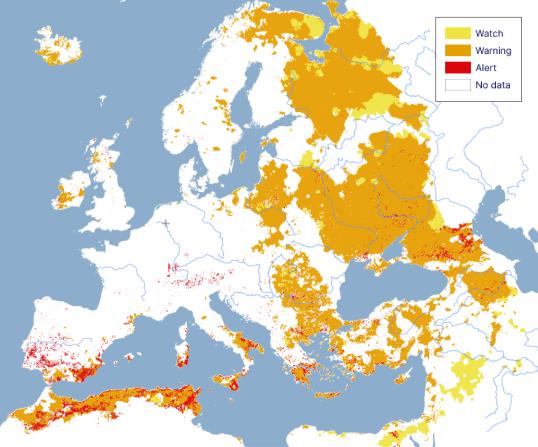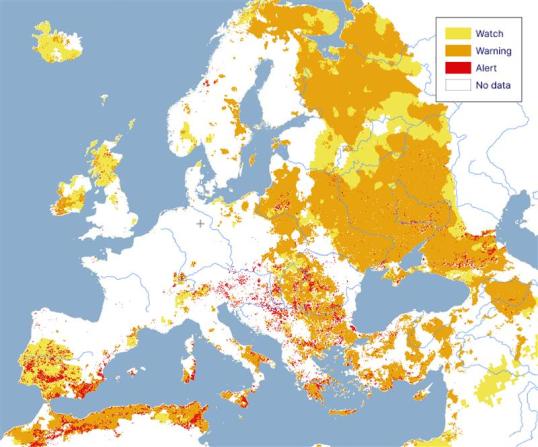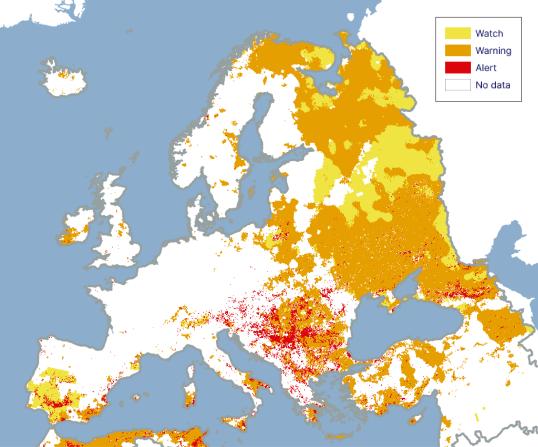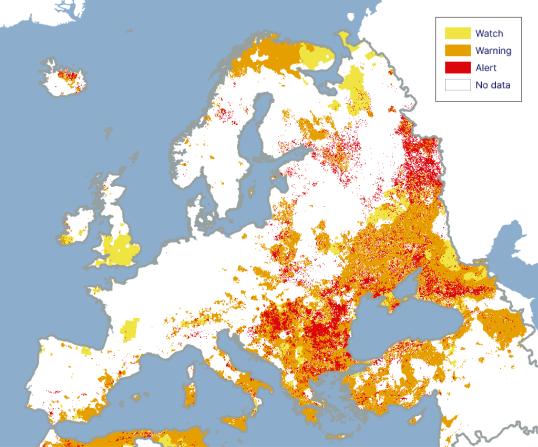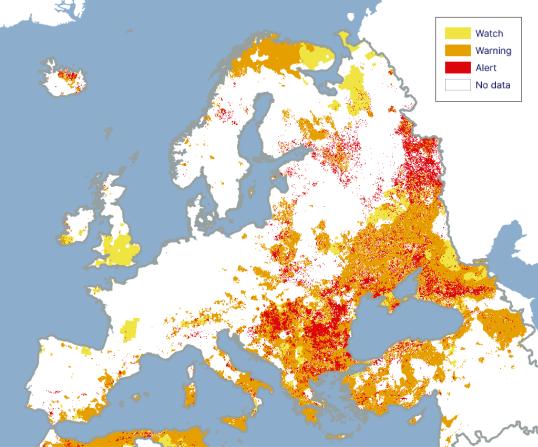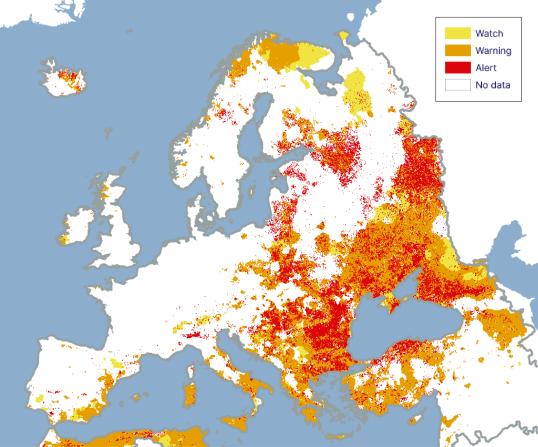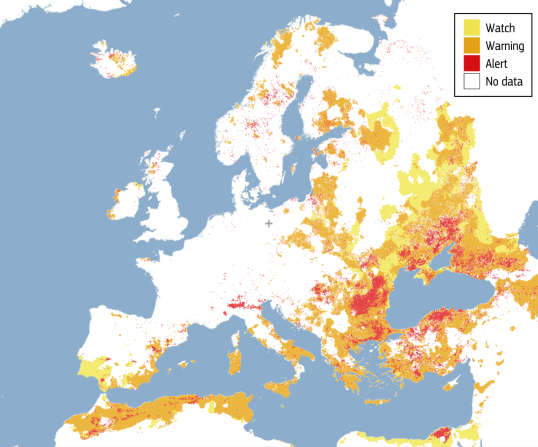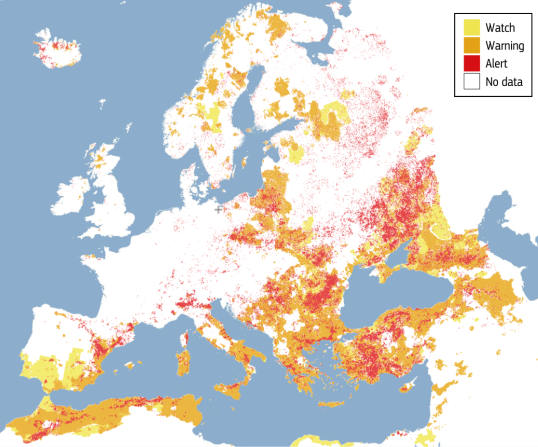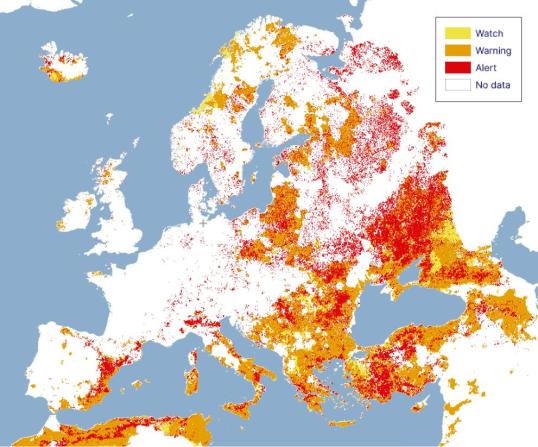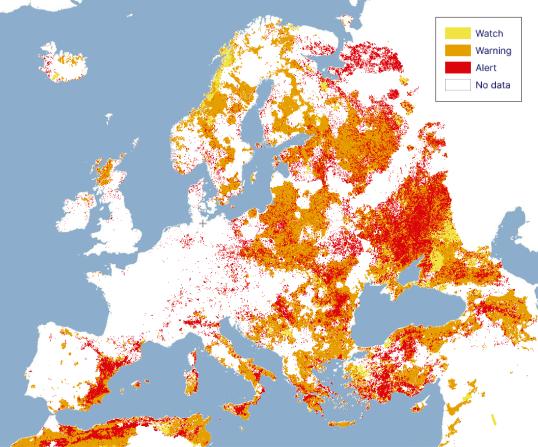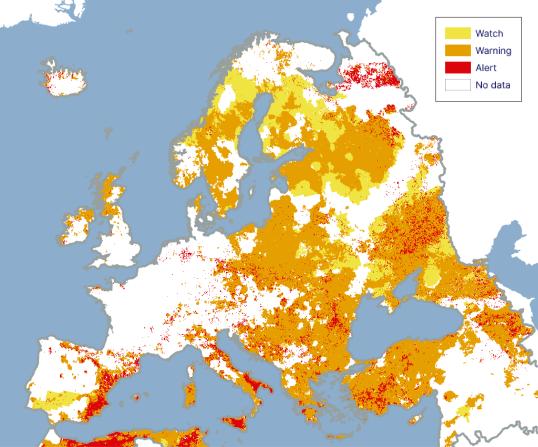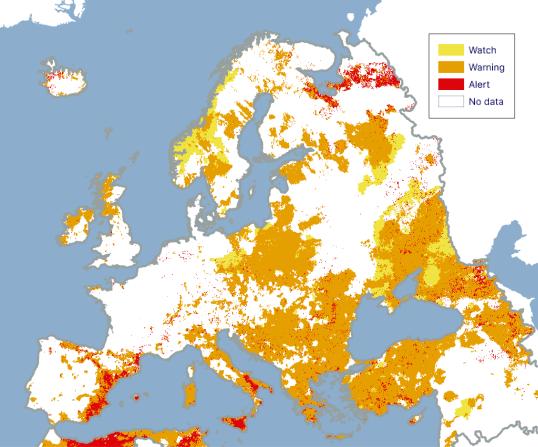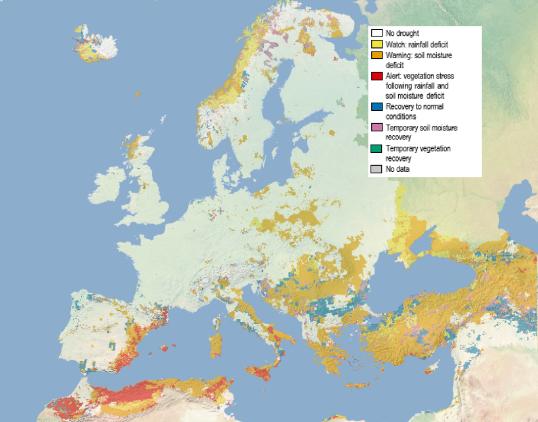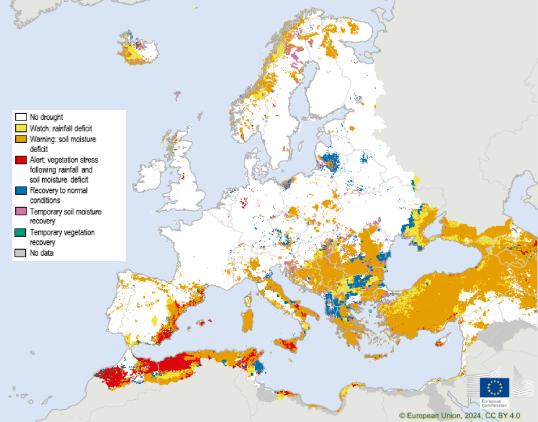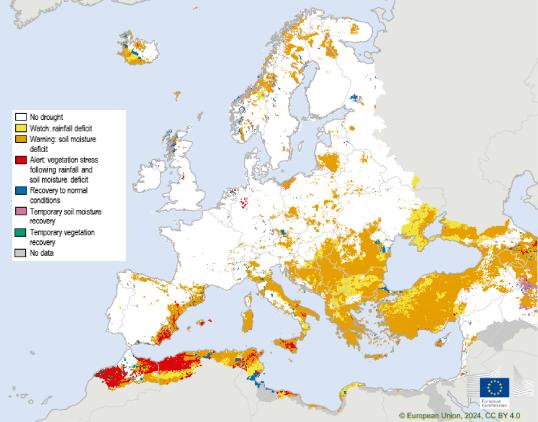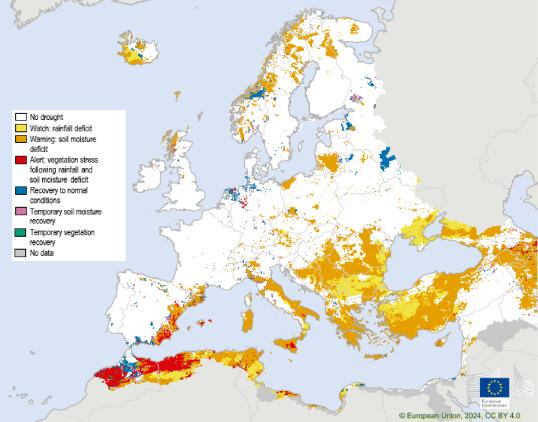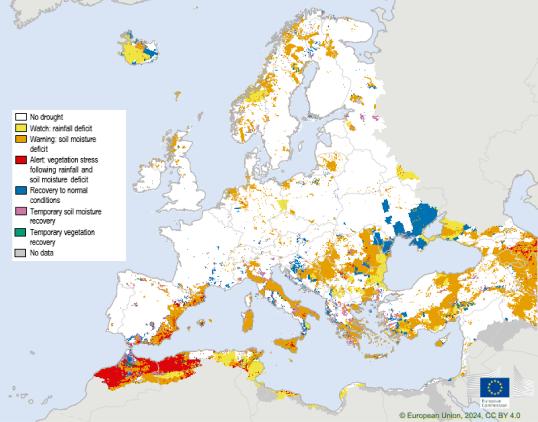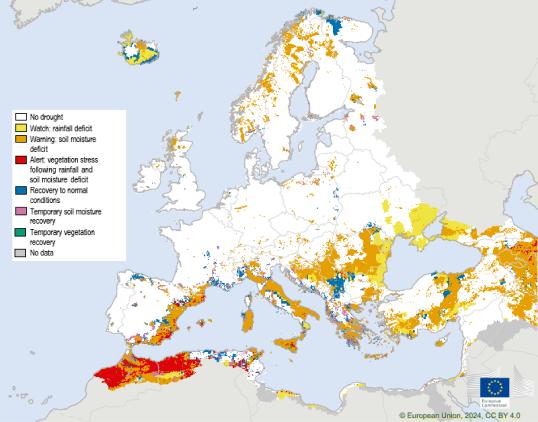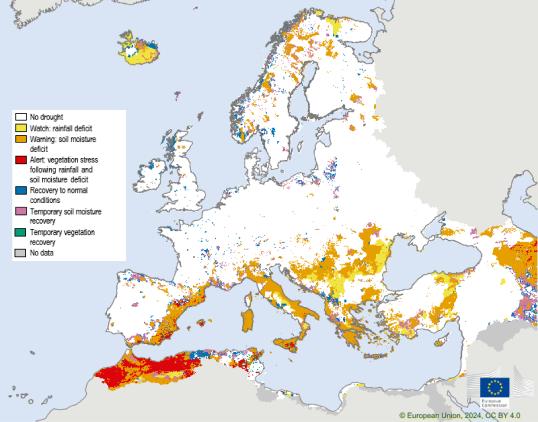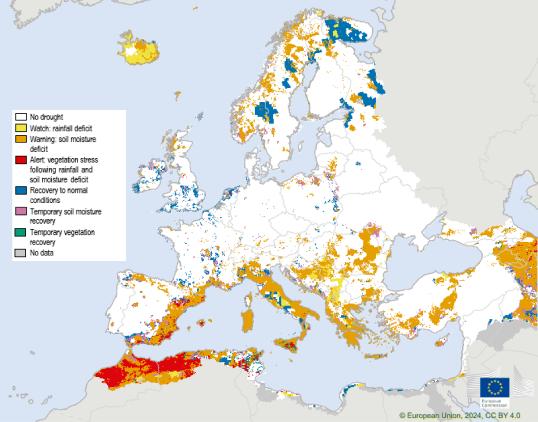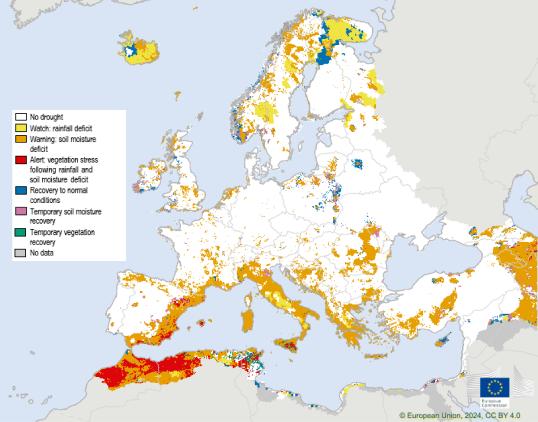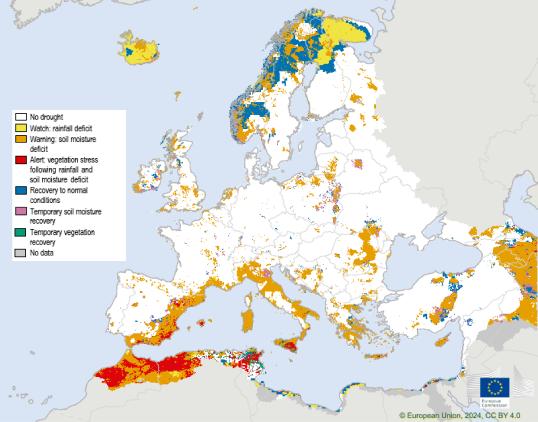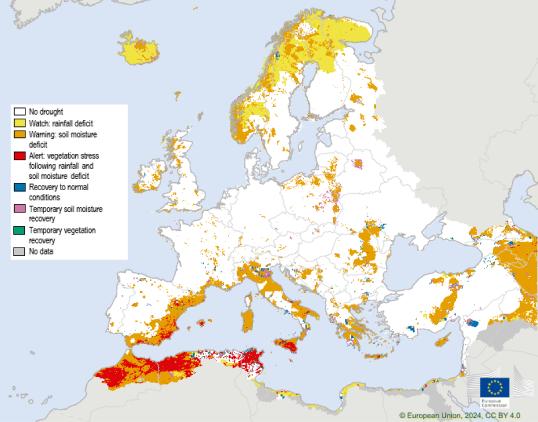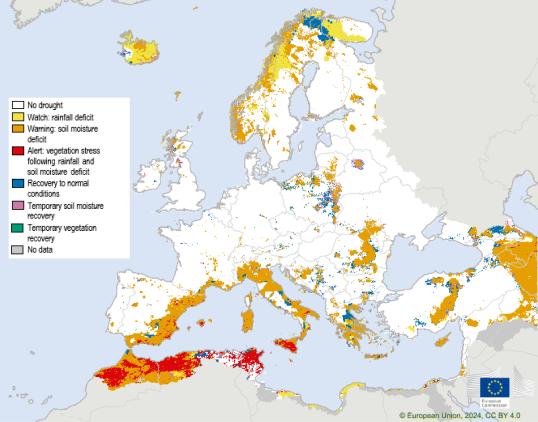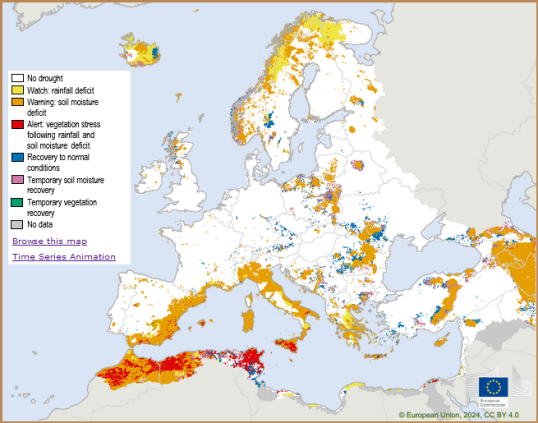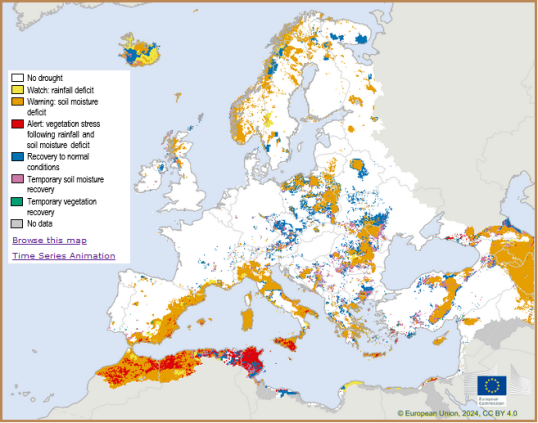According to the map, 15.9% of the EU-27 territory (without Madeira, Azores, Canary Islands) plus the United Kingdom is in Warning conditions and 0.7% is in Alert conditions.
The map shows slowly changing drought conditions across southern and eastern Europe in late December.
Severe, enduring, and critical conditions persist in the Mediterranean, the Balkans and the Black Sea region. The Iberian Peninsula has experienced critical conditions, with extreme impacts resulting from alternating drought periods and intense precipitation. In southeastern Spain drought conditions continue to severely affect vegetation. The spatial extent of drought in the Balkans is slowly decreasing.
By late December 2024, the Combined Drought Indicator (CDI) shows warning drought conditions in southern Italy, the eastern Baltic Sea region, Greece, part of the Balkans, Belarus, central-eastern Ukraine, southern and western Russia, Cyprus, Malta and other Mediterranean islands, as well as Ireland, northern UK, and most of Türkiye.
Wide regions in central-eastern Europe and southern Scandinavia, along with some areas in the western Iberian Peninsula, are under watch conditions due to a precipitation deficit. It is important to note that during the winter months, drought impacts are mainly limited to the drainage system, as most vegetation is dormant or absent during this season. This applies to all areas roughly north of Madrid, Naples and Athens.
Most of Scandinavia, southern Great Britain, the majority of the Iberian Peninsula, France, Benelux, Germany, Switzerland, northern and central Italy, western Balkans, Czechia, western Ukraine, Moldova, eastern Romania, and eastern Bulgaria show normal or recovery conditions.
Some areas in the Mediterranean region, particularly in southeastern Spain, southern Greece, western Türkiye are under persistent alert drought conditions, with impacts on the vegetation. This severe and prolonged drought is even more intense in some regions in Morocco, Algeria, and Tunisia, causing significant impacts.
During this 10-day period temperatures were close to or slightly above the seasonal average in Europe, with a short warm spell in southern Scandinavia and below-average snow persistence in the Southern Alps due to high temperatures.
Note: this analysis was performed on 07-01-2025, based on data referring to late December, and computed with version 4.0 of the Combined Drought Indicator.

Beginning of December 2024
The map shows stable drought conditions across southern and eastern Europe. Severe, enduring, and critical conditions persist in the Mediterranean, the Balkans and the Black Sea region. The Iberian Peninsula has experienced critical conditions, with extreme impacts resulting from prolonged drought followed by intense precipitation. In South-eastern Spain, previous drought conditions continue to severely affect vegetation. The spatial extent of drought in eastern Europe is slowly decreasing.
By early December 2024, the Combined Drought Indicator (CDI) shows warning drought conditions in southern Italy, eastern Baltic Sea region, Greece, most of the eastern Balkans, Belarus, central-eastern Ukraine, Southern and western Russia, Cyprus, Malta and other Mediterranean islands, as well as Ireland, northern Great Britain, and most of Türkiye. Sparse regions in western Russia, southern Scandinavia, northern UK, and Iceland are under watch conditions due to precipitation deficit.
Several areas of Scandinavia, southern Great Britain, the majority of Iberian Peninsula, France, Benelux, Germany, Austria, Switzerland, northern and central Italy, western Balkans, Czechia, a strip from western Ukraine to eastern Bulgaria and the majority of Hungary show normal or recovery conditions.
Some areas in the Mediterranean region, particularly in southeastern Spain, southern Italy, southern Greece, western Türkiye are under persistent alert drought conditions, with impacts on the vegetation. This severe and prolonged drought is even more intense in some regions in Morocco, Algeria, and Tunisia, causing significant impacts.
During this 10-day period temperatures were above the seasonal average in the Mediterranean during the first days and in Western Europe during the last days. In other regions and during the central days, temperatures were close to or below the seasonal average.
Note: this analysis was performed on 19-12-2024, based on data referring to early December, and computed with version 4.0 of the Combined Drought Indicator.
- End of November 2024 (3rd ten-day period)
The map shows stable drought conditions across southern and eastern Europe. However, severe, enduring, and critical conditions persist in the Mediterranean, the Balkans and the Black Sea region. The Iberian Peninsula, in particular, has experienced critical conditions, with extreme impacts resulting from prolonged drought followed by intense precipitation.
In South-eastern Spain, previous drought conditions continue to severely affect vegetation. The spatial extent of drought in eastern Europe is slowly decreasing.
By late November 2024, the Combined Drought Indicator (CDI) shows warning drought conditions in southern Italy, Lithuania, Kaliningrad Oblast, eastern Poland, Greece, most of the eastern Balkans, Belarus, central-eastern Ukraine, Southern and western Russia, Cyprus, Malta and other Mediterranean islands, as well as Ireland, northern Great Britain, and most of Türkiye.
Sparse regions in central-northern Italy, western Russia, southern Scandinavia, eastern Austria, and eastern Europe are under watch conditions due to precipitation deficit.
Several areas of Scandinavia, Great Britain, central and northern Iberian Peninsula, France, Benelux, Germany, western Austria, Switzerland, northern and central Italy, western Balkans, Czechia, a strip from western Ukraine to eastern Romania and the majority of Hungary show normal or recovery conditions.
Some areas in the Mediterranean region, particularly in southeastern Spain, southern Italy, southern Greece, south-western Türkiye are under persistent alert drought conditions, with impacts on the vegetation. This severe and prolonged drought is even more intense in some regions in Morocco, Algeria, and Tunisia, causing significant impacts. Alert conditions are reducing in Eastern Europe where some regions are transitioning to recovery condition for vegetation and soil moisture.
During this period, temperatures were above the seasonal average in many regions of western and central Europe, whit the highest anomalies in the Iberian Peninsula.
Note: this analysis was performed on 10-12-2024, based on data referring to late November, and computed with version 4.0 of the Combined Drought Indicator.
End of October
The map shows a progressive reduction in drought conditions across western, southern, and eastern Europe. However, severe, enduring, and critical conditions persist in the Mediterranean, Balkans and the Black Sea region. The Iberian Peninsula is experiencing critical conditions, with extreme impacts resulting from prolonged drought followed by intense precipitation.
This analysis refers to a period including the recent floods in the Valencia region in Spain, which occurred at the end of October. The impact of these floods could be already visible in the data, overlapping with the prolonged drought impacts. The relationship between the recent floods and the preceding drought is complex. Drought can lead to soil sealing, where rainfall struggles to penetrate well in the soil after a dry period. Further research will reveal whether this phenomenon worsened the situation in Eastern Spain.
The spatial extent of the drought is slowly reducing in southern and eastern Europe thanks to normal precipitation.
By late October 2024, the Combined Drought Indicator (CDI) shows warning drought conditions in southeastern Spain, southern Italy, Lithuania, Kaliningrad Oblast, eastern Poland, Greece, most of the eastern Balkans, Belarus, central-eastern Ukraine, Southern Russia, Cyprus, Malta and other Mediterranean islands, as well as south Ireland and extensive areas in central, western and northern Türkiye. Sparse regions in western Russia, Greece, Türkiye and eastern Europe are under watch conditions due to a long-lasting precipitation deficit.
Several areas of Scandinavia, Great Britain, north of Ireland, central and northern Iberian Peninsula, France, Benelux, Germany, Austria, Switzerland, northern and central Italy, western Balkans, Czechia, a strip from western Ukraine to eastern Romania and the majority of Hungary show normal or recovery conditions.
Some areas in the Mediterranean region, particularly in southern Italy, southern Greece, south-western Türkiye are under persistent alertdrought conditions, with impacts on the vegetation. This severe and prolonged drought is even more intense in some regions in Morocco, Algeria, and Tunisia, causing significant impacts. Alert conditions are reducing in Eastern Europe where some regions are transitioning to vegetation recovery condition. Alert conditions are present in the Iberian Peninsula, persisting also over wet regions.
During this period, temperatures were above the seasonal average in many regions of Europe except for the Iberian Peninsula.
Note: this analysis was performed on 11-11-2024, based on data referring to late October, including the flooding events in Eastern Spain. It was computed with version 4.0 of the Combined Drought Indicator.
Mid-October
The map shows a reduction and some improvements in drought conditions across western, southern, and eastern Europe. However, severe, enduring, and critical conditions persist in the Mediterranean, Balkans and the Black Sea region.
The Iberian Peninsula is experiencing critical conditions, with extreme impacts resulting from prolonged drought followed by intense precipitation. The spatial extent of the drought is slowly reducing in southern and eastern Europe thanks to normal precipitation.
By mid-October 2024, the Combined Drought Indicator (CDI) shows warning drought conditions in southeastern Spain, southern Italy, Lithuania, Kaliningrad Oblast, eastern Poland, southern Greece, most of the eastern Balkans, Belarus, central-eastern Ukraine, Southern Russia, Cyprus, Malta and other Mediterranean islands, as well as south-west Ireland and extensive areas in central, western and northern Türkiye.
Sparse regions in western Russia and eastern Europe are under watch conditions due to a long-lasting precipitation deficit.
Several areas of Scandinavia, Great Britain, north of Ireland, central and northern Iberian Peninsula, France, Benelux, Germany, Austria, Switzerland, northern Italy, and Czechia show normal or recovery conditions. Large regions in the south-western Iberian Peninsula, in the Alps, in western Balkans, in Hungary and in eastern Europe are under recovery conditions because of abundant precipitation.
Some areas in the Mediterranean region, particularly in southern Italy, south-eastern and southern Greece, are under persistent alert drought conditions, with impacts on the vegetation. This severe and prolonged drought is even more intense in some regions in Morocco, Algeria, and Tunisia, causing significant impacts. Alert conditions are reducing in Eastern Europe where some regions are transitioning to vegetation recovery condition. Alert conditions are present in the Iberian Peninsula, persisting also in over wet regions.
During this period, temperatures were slightly above the seasonal average in many regions of Europe.
This analysis refers to a period prior the recent floods in the Valencia region in Spain, which occurred at the end of October. As a result, the impact of these floods is not yet visible in the data. It is too early to understand the relationship between the recent floods and the preceding drought. Drought can lead to soil sealing, where rainfall struggles to penetrate well to the soil after a dry period. Further research will reveal whether this phenomenon worsened the situation in Eastern Spain.
Note: this analysis was performed on 05-11-2024, based on data referring to mid-October, before the flooding events in Eastern Spain, and computed with version 4.0 of the Combined Drought Indicator.
Beginning of October
The map shows slowly reducing and improving drought conditions across southern and eastern Europe. Severe, enduring, and critical conditions in the Mediterranean, Balkans and the Black Sea region are still present. The Iberian Peninsula is experiencing worsening drought conditions that are affecting vegetation. The spatial extent of the drought is slowly reducing in southern and eastern Europe thanks to precipitation.
By early October 2024, the Combined Drought Indicator (CDI) shows warning drought conditions in southeastern Spain, southern Italy, Estonia, Lithuania, Kaliningrad Oblast, southern and eastern Poland, Slovakia, southern Greece, most of the eastern Balkans, Belarus, Ukraine, Southern Russia, Cyprus, Malta and other Mediterranean islands, as well as south-west Ireland and extensive areas in central, western and northern Türkiye. The south-west area of the Iberian Peninsula, western Ireland, northern Great Britain, south-eastern Mediterranean, and sparse regions in western Russia, eastern Europe, the Alps and some spots in northeastern Spain and southern France are under watch conditions due to a recent precipitation deficit.
Several areas of Scandinavia, the centre and south of Great Britain, north of Ireland, central and northern Iberian Peninsula, France, Benelux, Germany, the majority of Switzerland, northern Italy, and Czechia show no drought or recovery conditions. Sparse regions in southern and eastern Europe are under recovery conditions as well.
Some areas in the Mediterranean region - particularly in southern Italy - eastern and southern Spain and Greece, are under persistent alert drought conditions, with impacts on the vegetation. This severe and prolonged drought is even more intense in some regions in Morocco, Algeria, and Tunisia, causing significant impacts. Alert conditions are reducing in Eastern Europe where there are regions under vegetation recovery condition. Alert conditions are quickly emerging and expanding over the south-western Iberian Peninsula.
During this period, temperatures were above the seasonal average in eastern Europe and in the Iberian Peninsula, with a short and local warm spell in eastern Europe.
Note 1: this analysis was performed on 24-09-2024, based on data referring to beginnining of September and computed with version 4.0 of the Combined Drought Indicator.
Note 2: the results of the CDI Map in Poland and Northern Italy are affected by issues with the meteorological forcing data. These data are being re-evaluated and subsequently the indicators will be reprocessed.
- End of September 2024 (3rd ten-day period)
The map shows persistent and stable drought conditions across southern and eastern Europe, with severe, enduring, and critical conditions in the Mediterranean, Balkans and the Black Sea region.
Eastern Europe is experiencing critical drought conditions that are affecting crops and vegetation. The spatial extent of the drought is slowly reducing in southern and eastern Europe thanks to precipitation recover.
By late September 2024, the Combined Drought Indicator (CDI) shows warning drought conditions in southeastern Spain, southern Italy, Estonia, Lithuania, Kaliningrad Oblast, southern and eastern Poland, Slovakia, southern Greece, most of the Balkans, Belarus, Ukraine, Southern Russia, Cyprus, Malta and other Mediterranean islands, as well as south-west Ireland and extensive areas in central, western and northern Türkiye.
South-west Iberian Peninsula, south-eastern Mediterranean, and sparse regions in western Russia and Poland are under watch conditions due to a recent precipitation deficit.
Several areas of Scandinavia, the majority of Great Britain, north of Ireland, central and northern Iberian Peninsula, France, Benelux, Germany, the majority of Switzerland, northern Italy, and Czechia show no drought or recovery conditions. Sparse regions in southern and eastern Europe are under recovery conditions as well.
Some areas in the Mediterranean region - particularly in southern Italy - eastern and southern Spain and Greece, are under persistent alert drought conditions, with impacts on the vegetation. This severe and prolonged drought is even more intense in some regions in Morocco, Algeria, and Tunisia causing significant impacts. Alert conditions are intensifying in Eastern Europe, particularly in Ukraine, central and eastern Balkans, Hungary, and southern Russia.
During this period, temperatures were above the seasonal average in eastern Europe, with short heatwaves affecting eastern Europe.
Note: this analysis was performed on 23-10-2024, based on data referring to late September and computed with the version 4.0 of the Combined Drought Indicator.
- Mid-September 2024
The map shows persistent and stable drought conditions across southern and eastern Europe, with severe, enduring, and critical conditions in the Mediterranean, Balkans and the Black Sea region. Eastern Europe is experiencing critical drought conditions that are affecting crops and vegetation.
By mid-September 2024, the Combined Drought Indicator (CDI) shows warning drought conditions in eastern Spain, most of southern Italy, Estonia, Lithuania, Kaliningrad Oblast, southern and eastern Poland, Slovakia, Greece, most of the Balkans, Belarus, Ukraine, Southern Russia, Cyprus, Malta and other Mediterranean islands, as well as extensive areas in central, western and northern Türkiye. Eastern United Kingdom, southern Ireland, north-eastern Europe, north-west Iberian Peninsula, and south-eastern Mediterranean are under watch conditions due to a recent precipitation deficit.
Several areas of the Alps, the eastern parts of Austria and Slovenia, and some areas in Slovakia and Hungary show recovery conditions as an effect of the heavy rainfalls from storm Boris hitting Central-Eastern Europe from the 12/13 September. Other recovery conditions due to recent precipitation are present in internal regions at the border between Spain and Portugal and in scattered areas in Poland, Ukraine, Greece and Türkiye.
Several areas of Scandinavia, the majority of Great Britain, north of Ireland, central and northern Iberian Peninsula, France, Benelux, Germany, part of Switzerland, and Czechia show no drought or recovery conditions.
Some areas in the Mediterranean region - particularly in central and southern Italy - eastern Spain, Greece, and central-northern Türkiye, are under persistent alert drought conditions, with impacts on the vegetation. This severe and prolonged drought is even more intense in some regions in Morocco, Algeria, and Tunisia causing significant impacts. Alert conditions are intensifying in Eastern Europe, particularly in Ukraine, Moldova, central and eastern Balkans, Hungary, and southern Russia. Sparse alert conditions over Poland are likely not due to drought conditions.
During this period, temperatures were above the seasonal average in Northern and Eastern Europe, with heatwaves affecting Eastern Europe from the White Sea to the Black Sea, across Finland, western Russia, eastern Baltic regions, Belarus, Ukraine, and northern Türkiye.
Note 1: this analysis was performed on 30-09-2024, based on data referring to mid of September and computed with the version 4.0 of the Combined Drought Indicator.
Note 2: the results of the CDI Map in Poland and Northern Italy are affected by issues with the meteorological forcing data. These data are being re-evaluated and subsequently the indicators will be reprocessed.
- Early September 2024
The map displays persistent and stable drought conditions across southern and eastern Europe, with severe, enduring, and critical conditions in the Mediterranean, Balkans and the Black Sea region. Eastern Europe is experiencing critical drought conditions that are affecting crops and vegetation.
As of beginning of September 2024, the Combined Drought Indicator (CDI) shows warning drought conditions in eastern Spain, most of southern Italy, Estonia, Lithuania, Kaliningrad Oblast, southern and eastern Poland, Slovakia, Greece, most of the Balkans, Austria, Ukraine, Southern Russia, Cyprus, Malta and other Mediterranean islands, as well as extensive areas in central-western and northern Türkiye.
Some regions in the Alps, north-eastern Europe, internal regions at the border between Spain and Portugal, and south-eastern Mediterranean are under watch conditions due to a recent precipitation deficit.
Southern UK, Ireland, central France, and small, scattered areas in Ukraine and Türkiye show recovery conditions thanks to recent precipitation. Several areas of Scandinavia, central-northern United Kingdom, most of Ireland, central and northern Iberian Peninsula, most of France, Benelux, Germany, part of Switzerland, and Czechia show no drought or recovery conditions. However, local extreme wet conditions in the past months have led to reduced crop yields.
Some areas in the Mediterranean region, particularly in central and southern Italy, eastern Spain, north-eastern Greece, and central-northern Türkiye, are under persistent alert drought conditions, with impacts on the vegetation. This severe and prolonged drought is even more intense in some regions in Morocco, Algeria, and Tunisia causing significant impacts. Alert conditions are intensifying in Eastern Europe, particularly in Ukraine, Moldova, central and eastern Balkans, Hungary, and southern Russia. Sparse alert conditions over Poland are likely not due to drought conditions.
During the first ten days of September, temperatures in most of Europe were above the seasonal average, with severe heatwaves in central-eastern Europe from the Baltic Sea to the Mediterranean and in Ukraine, reducing or moving to East at the end of the period.
Note 1: this analysis was performed on 24-09-2024, based on data referring to beginnining of September and computed with version 4.0 of the Combined Drought Indicator.
Note 2: the results of the CDI Map in Poland and Northern Italy are affected by issues with the meteorological forcing data. These data are being re-evaluated and subsequently the indicators will be reprocessed.
End of August 2024
The map displays persistent and stable drought conditions across southern and eastern Europe, with severe, enduring, and critical conditions in the Mediterranean, Balkans and the Black Sea region. Eastern Europe is experiencing critical drought conditions that are affecting crops and vegetation.
As of late August 2024, the Combined Drought Indicator (CDI) shows warning drought conditions in eastern Spain, most of southern Italy, south-east Poland, southern Baltic regions, Greece, most of the Balkans, Ukraine, Southern Russia, Cyprus, Malta, Mediterranean islands, and extensive areas in central-western and northern Türkiye.
Some regions in north-eastern Europe, part of southern UK, central France, central Portugal, and south-eastern Mediterranean are under watch conditionsdue to a recent precipitation deficit.
Southern UK, central France, and small, scattered areas across central-eastern Europe show recovery conditions due to recent precipitation. Several areas of Scandinavia, central-northern United Kingdom, most of Ireland, central and north-western Iberian Peninsula, most of France, Benelux, Germany, part of Hungary, Switzerland, Austria, Czechia, and Slovakia also show recovery or normal conditions. However, local extreme wet conditions in the past months have led to reduced crop yields.
Some areas in the Mediterranean region, particularly in central and southern Italy, north-eastern Spain, north-eastern Greece, and central-northern Türkiye, are under persistent alert drought conditions, with impacts on the vegetation. This severe and prolonged drought is even more intense in some regions in Morocco, Algeria, and Tunisia causing significant impacts. Alert conditions are intensifying in Eastern Europe, particularly in Ukraine, Moldova, Romania, Bulgaria, North Macedonia, eastern Croatia, northern Serbia, southern Hungary, and southern Russia. Sparse alert conditions over Baltic regions and Poland are likely not due to drought conditions; additionally, in those regions, vegetation is showing some recovery compared to the previous 10-day period.
During this period, temperatures in most of Europe were above the seasonal average, with severe heatwaves in central-eastern Europe.
Note 1: this analysis was performed on 16-09-2024, based on data referring to late August and computed with version 4.0 of the Combined Drought Indicator.
Note 2: the results of the CDI Map in Poland and Northern Italy are affected by issues with the meteorological forcing data. These data are being re-evaluated and subsequently the indicators will be reprocessed.
Mid-August 2024
The map displays persistent and recurrent drought conditions across southern and eastern Europe, with severe, enduring, and critical conditions in the Mediterranean, Balkans and the Black Sea region.
Eastern Europe is experiencing critical drought conditions that are affecting crops and vegetation.
As of mid-August 2024, the Combined Drought Indicator (CDI) shows warning drought conditions in eastern Spain, most of southern Italy, south-east Poland, southern Baltic regions, Greece, most of the Balkans, Ukraine, Southern Russia, Cyprus, Malta, Mediterranean islands, and extensive areas in central-western and northern Türkiye.
Some regions in north-eastern Europe, southern UK and central France are under watch conditions due to a recent precipitation deficit.
Small, scattered areas across central-eastern Europe and the Iberian Peninsula show recovery conditions due to recent precipitation. Several areas of Scandinavia, most of the United Kingdom, most of Ireland, central and north-western Iberian Peninsula, most of France, Benelux, Germany, part of Hungary, Switzerland, Austria, Czechia, and Slovakia also show recovery or normal conditions. However, local extreme wet conditions in the past months have led to reduced crop yields.
Some areas in the Mediterranean region, particularly in central and southern Italy, north-eastern Spain, north-eastern Greece, and central-northern Türkiye, are under persistent alert drought conditions, with impacts on the vegetation. This severe and prolonged drought is even more intense in some regions in Morocco, Algeria, Tunisia, and Egypt causing significant impacts. Alert conditions are rapidly intensifying in Eastern Europe, particularly in Ukraine, Romania, Bulgaria, northern Serbia, southern Hungary, and southern Russia.
Sparse alert conditions over Baltic regions and Poland are likely not due to drought conditions; additionally, in those regions, vegetation is showing some recovery compared to the previous 10-day period.
During this period, temperatures in most of Europe were above the seasonal average, with severe heatwaves in Italy, the Iberian Peninsula, and south-eastern Europe.
Note 1: this analysis was performed on 03-09-2024, based on data referring to early August and computed with version 4.0 of the Combined Drought Indicator.
Note 2: the results of the CDI Map in Poland and Northern Italy are affected by issues with the meteorological forcing data. These data are being re-evaluated and subsequently the indicators will be reprocessed.
Beginning of August 2024
The map displays persistent and recurrent drought conditions across southern and eastern Europe, with severe, enduring, and critical conditions in the Mediterranean and the Black Sea region.
Eastern Europe is experiencing critical drought conditions that are affecting crops and vegetation, while Scandinavia has variable drought conditions.
As of early August 2024, the Combined Drought Indicator (CDI) shows warning drought conditions in eastern Spain, most of southern and central-eastern Italy, south Poland, southern Baltic regions, Greece, most of the Balkans, Ukraine, Southern Russia, Cyprus, Malta, Mediterranean islands, and extensive areas in central-western and northern Türkiye.
Some regions in north-eastern Europe are under watch conditions due to a recent precipitation deficit.
The south-western Iberian Peninsula, and some sparse small areas across central-eastern Europe show recovery conditions thanks to recent precipitation.
Several areas of Scandinavia, most of the United Kingdom, most of Ireland, central and north-western Iberian Peninsula, most of France, Benelux, Germany, part of Hungary, Switzerland, Austria, Czechia, and Slovakia also show recovery or normal conditions. However, local extreme wet conditions in the past months have led to reduced crop yields.
Some areas in the Mediterranean region, particularly in central and southern Italy, north-eastern Spain, north-eastern Greece, and central-northern Türkiye, are under persistent alert drought conditions, with impacts on the vegetation and devastative wildfires. This severe and prolonged drought is even more intense in some regions in Morocco, Algeria, Tunisia, and Egypt causing significant impacts.
Alert conditions are rapidly intensifying in Eastern Europe, particularly in Ukraine, Romania, Bulgaria, northern Serbia, southern Hungary, and southern Russia. Sparse alert conditions over Baltic regions and Poland are likely not due to drought conditions.
During this period, temperatures in southern and eastern Europe and in northern Scandinavia were above the seasonal average, with severe heatwaves in Italy and the Iberian Peninsula.
Note 1: this analysis was performed on 26-08-2024, based on data referring to early August and computed with version 4.0 of the Combined Drought Indicator.
Note 2: the results of the CDI Map in Poland and Northern Italy are affected by issues with the meteorological forcing data. These data are being re-evaluated and subsequently the indicators will be reprocessed.
End of July 2024
The map displays persistent and recurrent drought conditions across southern and eastern Europe, with severe, enduring, and critical conditions in the Mediterranean and the Black Sea region.
Compared to previous months, Eastern Europe is experiencing severely worsening drought conditions that are affecting crops and vegetation.
Scandinavia has variable drought conditions.
As of late July 2024, the Combined Drought Indicator (CDI) shows warning drought conditions in eastern Spain, most of southern and central-eastern Italy, Poland, southern Baltic regions, Greece, most of the Balkans, Ukraine, Southern Russia, western Cyprus, Malta, Mediterranean islands, and extensive areas in central-western and northern Türkiye.
The south-western Iberian Peninsula, and regions in eastern Europe are under watch conditions due to a recent precipitation deficit.
Sparse small areas across central-eastern Europe, Scandinavia, and central Spain show recovery conditions thanks to recent precipitation.
Several areas of Scandinavia, most of the United Kingdom, most of Ireland, central and north-eastern Iberian Peninsula, most of France, Benelux, Germany, most of Hungary, Switzerland, Austria, Czechia, and Slovakia also show recovery or normal conditions. However, local extreme wet conditions are leading to reduced crop yields.
Some areas in the Mediterranean region, particularly in central and southern Italy, north-western Spain, north-eastern Greece, and central-northern Türkiye, are under persistent alert drought conditions, with impacts on the vegetation. This severe and prolonged drought is even more intense in some regions in Morocco, Algeria, Tunisia, and Egypt causing significant impacts. Alert conditions are rapidly intensifying in Eastern Europe, particularly in Ukraine, Romania, Bulgaria, northern Serbia, southern Hungary, and southern Russia. Sparse alert conditions over Baltic regions and Poland are likely not due to drought conditions.
During this period, temperatures in southern and eastern Europe and in northern Scandinavia were above the seasonal average, with severe heatwaves in eastern Europe, Mediterranean, and the Iberian Peninsula.
Note 1: this analysis was performed on 13-08-2024, based on data referring to late July and computed with version 4.0 of the Combined Drought Indicator.
Note 2: the results of the CDI Map in Poland and Northern Italy are affected by issues with the meteorological forcing data. These data are being re-evaluated and subsequently the indicators will be reprocessed.
Mid-July 2024
The map displays persistent and recurrent drought conditions across southern and eastern Europe, with severe, enduring, and critical conditions in the Mediterranean and the Black Sea region. Compared to previous months, Eastern Europe is experiencing worsening drought conditions that are affecting crops and vegetation. Scandinavia has variable drought conditions.
As of mid-July 2024, the Combined Drought Indicator (CDI) shows warning drought conditions in eastern Spain, most of southern and central-eastern Italy, most of Romania, Poland, Estonia and southern Baltic regions, Greece, most of the Balkans, Ukraine, Southern Russia, western Cyprus, Malta, Mediterranean islands, and extensive areas in western and northern Türkiye. The south-western Iberian Peninsula, and regions in eastern Europe are under watch conditions due to a recent precipitation deficit.
Sparse areas across Central-eastern Europe, Scandinavia, and central Spain show recovery conditions thanks to recent precipitation.
Several areas of Scandinavia, most of the United Kingdom, most of Ireland, central and north-eastern Iberian Peninsula, most of France, Benelux, Germany, most of Hungary, Switzerland, Austria, Czechia, and Slovakia also show recovery or normal conditions. However, local extreme wet conditions are leading to reduced crop yields.
Large areas in the Mediterranean region, particularly in central and southern Italy, north-western Spain, Greece, and central-western Türkiye, are under persistent alert drought conditions, with impacts on the vegetation. This severe and prolonged drought is even more intense in some regions in Morocco, Algeria, and Tunisia, causing significant impacts. Alert conditions are progressively intensifying in Eastern Europe, particularly in Ukraine, Romania, Southern Hungary and Southern Russia, where a drought emergency has been declared in Rostov Oblast.
During this period, temperatures in Europe were above the seasonal average, with heatwaves in eastern Europe and Mediterranean.
Note 1: this analysis was performed on 01-08-2024, based on data referring to mid-July and computed with version 4.0 of the Combined Drought Indicator.
Note 2: the results of the CDI Map in Poland and Northern Italy are affected by issues with the meteorological forcing data. These data are being re-evaluated and subsequently the indicators will be reprocessed.
Beginning of July 2024
The map displays worsening and potentially drought critical conditions in the Mediterranean regions, while most of the rest of Europe has seen an improvement in drought hazard at the beginning of January. Eastern Europe has also experiencing some progressive recovering.
The Combined Drought Indicator (CDI) at the beginning of January 2024 indicated south-eastern Spain, southern France, most of Italy, eastern Poland, central Romania, southern Greece, and central Türkiye were in warning conditions.
In most of Scandinavia, the UK, Ireland, most of the Iberian Peninsula, most of France, the Netherlands, Germany, most of Poland, Austria, Czechia, Slovakia, Hungary, Ukraine, Lithuania, Belarus, the Balkans, most of Türkiye, and northern Greece scattered warning conditions were decreasing and mostly theere were recovery or normal conditions.
Some regions of northern Scandinavia experienced meteorological drought, as reflected by the CDI that indicated watch conditions due to lack of precipitation.
Some areas in the Mediterranean, particularly southern Italy and southern Spain, were under “alert” conditions, with vegetation affected by the drought. This phenomenon is much more severe and prolonged in Morocco, Algeria and Tunisia where the situation appears to be serious. Morocco is entering its sixth consecutive year of drought.
During this period, temperatures have been above the seasonal average in central and southern Europe, with a short warm spell in eastern Europe. In the Alps, the snowpack is lower than usual. Temperatures have been lower than usual in northern Europe.
End of June 2024
The map displays persistent drought conditions in southern Europe, with severe, enduring, and critical conditions in the Mediterranean region. Compared to the previous period, Eastern Europe is experiencing worsening drought conditions that are affecting crops and vegetation. Scandinavia has variable drought conditions.
The Combined Drought Indicator (CDI) for late-June 2024 indicates warning drought conditions in eastern Spain, most of southern and central-eastern Italy, most of Romania, Poland, southern Baltic regions, most of Greece, Balkans, western Cyprus, Malta, and several Mediterranean islands, and wide regions in Türkiye. Watch conditions affect the southern Iberian Peninsula, regions in eastern Europe, and central Scandinavia due to a recent precipitation deficit.
Recovery conditions are present sparsely in central-eastern Europe and Scandinavia thanks to recent precipitation.
In northern Scandinavia, most of the United Kingdom, Ireland, central and north-eastern Iberian Peninsula, most of France, Benelux, Germany, Austria, Czechia, and Slovakia show recovery or normal conditions, with some local extreme wet conditions leading to impacts on crop conditions. These impacts arise from the impossibility for farmers to access their fields with heavy machinery due to the soaked soil, various types of mould affecting the crops and lack of sunshine needed for ripening.
Large areas in the Mediterranean region, particularly in central and southern Italy, north-western Spain, Greece, and south-western Türkiye, were under alert drought conditions, with impacts on vegetation. This phenomenon remains much more severe and prolonged in northern Morocco, Algeria, and Tunisia, causing significant impacts. Alert conditions are progressively and intensively affecting Eastern Europe, particularly Ukraine, Romania, and Southern Russia. In the Rostov area, a drought emergency has been declared.
During this period, temperatures were above the seasonal average in Europe.
Note 1: this analysis was performed on 10-07-2024, based on data from late June and computed with the version 4.0 of the Combined Drought Indicator.
Note 2: the results of the CDI Map in Poland and Northern Italy are affected by issues with the meteorological forcing data. These data are being re-evaluated and subsequently the indicators will be reprocessed.
Mid-June 2024
The map displays persistent drought conditions in southern Europe, with severe, enduring, and critical conditions in the Mediterranean region.
Eastern Europe is experiencing sparse worsening drought conditions that are affecting crops and vegetation, even if recent precipitations have led to some recovery in certain areas. Scandinavia has variable drought conditions, and the recent significant precipitation deficit has been almost fully recovered.
The Combined Drought Indicator (CDI) for mid-June 2024 indicated warning drought conditions in eastern Spain, most of southern and central-eastern Italy, Malta, most of Romania, Poland, Baltic regions, most of Greece, Balkans, western Cyprus, the Mediterranean islands, and wide regions in Türkiye.
Watch conditions affected sparse regions in eastern Europe, and central-western Scandinavia.
Recovery conditions are present sparsely in central-eastern Europe, United Kingdom, Ireland, and Scandinavia due to recent precipitation.
In northern Scandinavia, the southern United Kingdom, Ireland, the inner and Atlantic Iberian Peninsula, most of France, Benelux, Germany, Austria, Czechia, and Slovakia, there were recovery or normal conditions, with some local extreme wet conditions, leading to impacts on crop conditions.
Large areas in the Mediterranean region, particularly in central and southern Italy, Greece, and south-western Türkiye, were under alert drought conditions, with impacts on vegetation. This phenomenon remains much more severe and prolonged in northern Morocco, Algeria, and Tunisia, causing significant impacts. Alert conditions are progressively and intensively affecting eastern Europe as well, particularly Ukraine, Romania, and Southern Russia. In the Rostov area a drought emergency has been declared.
During this period, temperatures were close to the seasonal average in Europe, except in eastern Europe and western Iberian Peninsula, where they were above average.
Note 1: this analysis was performed on 05-07-2024, based on data from early June and computed with the uptated version 4.0 of the Combined Drought Indicator.
Note 2: the results of the CDI map in Poland and Northern Italy are affected by issues with the meteorological forcing data. These data are being re-evaluated and subsequently, the indicators will be reprocessed. At the moment, in both areas there are no reported droughts.
Beginning of June 2024
The map displays persistent drought conditions in southern Europe, with severe, enduring, and critical conditions in the Mediterranean region.
Eastern Europe is experiencing sparse worsening drought conditions affecting crop and vegetation even if recent precipitations have led to some recovery in certain areas. Scandinavia has variable drought conditions, and the recent significant precipitation deficit has been almost fully recovered.
The Combined Drought Indicator (CDI) for early June 2024 indicated warning drought conditions in eastern Spain, most of southern and central-eastern Italy, Malta, most of Romania, Poland, Baltic regions, most of Greece, northern Balkans, western Cyprus, the Mediterranean islands, and wide regions in Türkiye.
Watch conditions affected sparse regions in eastern Europe, and central-western Scandinavia.
Recovery conditions were present sparsely in central Balkans, central Europe, United Kingdom, Ireland, the Iberian Peninsula, and Scandinavia due to recent precipitation.
In northern Scandinavia, the southern United Kingdom, Ireland, the inner and Atlantic Iberian Peninsula, most of France, Benelux, Germany, Austria, Czechia, and Slovakia, there were recovery, normal conditions, with some local extreme wet conditions, leading to impacts on crop conditions related to limited access for machines to cultivated areas.
Large areas in the Mediterranean region, particularly in central and southern Italy, Greece, and south-western Türkiye, were under alert drought conditions, with impacts on vegetation. This phenomenon remains much more severe and prolonged in Algeria, and Tunisia, causing significant impacts.
Alert conditions are progressively and intensively affecting eastern Europe as well, particularly Ukraine, Romania, and Southern Russia. In the Rostov area a drought emergency has been declared.
During this period, temperatures were close to the seasonal average in central-southern Europe, and well above the average in Scandinavia and north-eastern Europe.
End of May 2024
The map displays persistent drought conditions in southern Europe as of late May, with severe, enduring and critical conditions in the south-western Mediterranean region.
Eastern Europe is experiencing worsening drought conditions, while Scandinavia has variable drought conditions and a recent significant precipitation deficit.
The Combined Drought Indicator (CDI) for late May 2024 indicated warning drought conditions in eastern Spain, most of southern and central-eastern Italy, Malta, most of Romania, Poland, Baltic regions, most of Greece, northern Balkans, western Cyprus, the Mediterranean islands, and most of Türkiye.
Watch conditions affected sparse regions in eastern Europe, central Scandinavia, and south-western Iberian Peninsula.
Recovery conditions were present in central Balkans, central Europe and southern Scandinavia due to recent precipitation.
In northern Scandinavia, the southern United Kingdom, Ireland, the inner and Atlantic Iberian Peninsula, most of France, Benelux, Germany, Austria, Czechia, and Slovakia, there were recovery or normal conditions.
Some areas in the Mediterranean region, particularly in central and southern Italy, Greece, and south-western Türkiye, were under alert drought conditions, with some impacts on vegetation. This phenomenon remains much more severe and prolonged in Morocco, Algeria and Tunisia, causing significant impacts.
During this period, temperatures were close to the seasonal average in central-southern Europe, and well above the average in Scandinavia and north-eastern Europe.
Mid-May 2024
The map displays persistent drought in southern Europe as of mid-May, with severe, enduring and critical conditions in the western Mediterranean region.
Eastern Europe is experiencing variable drought conditions, while Scandinavia has scattered drought spots with minimal impacts.
There are almost no signs of drought in the rest of Europe.
The Combined Drought Indicator (CDI) for mid-May 2024 indicated warning drought conditions in eastern Spain, most of southern and central-eastern Italy, Malta, most of Romania, eastern Poland, most of Greece, northern Balkans, western Cyprus, the Mediterranean islands, and most of Türkiye.
Watch conditions affected sparse regions in eastern Europe, north-western Türkiye, and western Scandinavia.
Recovery conditions persisted or evolved into no drought conditions in central Balkans following a brief precipitation deficit.
In most of Scandinavia, the United Kingdom, Ireland, the inner and Atlantic Iberian Peninsula, most of France, Benelux, Germany, most of Poland, Austria, Czechia, Slovakia, Hungary, most of Ukraine, Lithuania, and Belarus there were recovery or normal conditions.
Some areas in the Mediterranean region, particularly in southern Italy and eastern Spain, were under alert drought conditions, with some impacts on the vegetation. This phenomenon remains much more severe and prolonged in Morocco, Algeria and Tunisia, causing significant impacts.
During this period, temperatures were close to the seasonal average in central-southern Europe, and above the average in northern and western Europe. Brief heatwaves occurred in Scandinavia, northern UK and southern Italy.
Beginning of May 2024
The map displays persistent drought conditions in southern Europe in early May, with severe, persistent and critical conditions in the southern Mediterranean region.
South-eastern Europe is experiencing variable drought conditions. Scandinavia is seeing scattered drought spots with no significant impact. There are almost no signs of drought in the rest of Europe.
The Combined Drought Indicator (CDI) in early May 2024 indicated that eastern Spain, most of southern and central-eastern Italy, Malta, most of Romania, most of Greece, northern Balkans, western Cyprus, the Mediterranean islands, and most of Türkiye were in warning conditions.
Watch conditions affected sparse regions in central Balkans, north-western Türkiye, and eastern Ukraine.
Recovery conditions persisted or evolved into no drought conditions in central Balkans after the previous brief precipitation deficit.
In most of Scandinavia, the United Kingdom, Ireland, the inner and Atlantic Iberian Peninsula, most of France, Benelux, Germany, most of Poland, Austria, Czechia, Slovakia, Hungary, most of Ukraine, Lithuania, and Belarus there were recovery or normal conditions.
Some areas in the Mediterranean region, particularly in southern Italy and eastern Spain, were under alert conditions, with drought affecting vegetation. This phenomenon remains much more severe and prolonged in Morocco, Algeria and Tunisia, causing significant impacts.
During this period, temperatures have been close to the seasonal average across Europe, except for the Iberian Peninsula where they have been slightly warmer. A brief warm spell occurred in the UK.
End of April 2024
The map displays persistent drought conditions in southern Europe in late April, with severe and critical conditions in most of the Mediterranean region.
Southeastern Europe is experiencing variable drought conditions. Scandinavia is seeing scattered drought spots with no significant impact. There are almost no signs of drought in the rest of Europe.
The Combined Drought Indicator (CDI) in late April 2024 indicated that southern and eastern Spain, most of southern and central Italy, Malta, most of Romania, most of Greece, northern Balkans, Cyprus, and most of Türkiye were in warning conditions.
Watch conditions affected sparse regions in Bulgaria, central Balkans, north-western Türkiye, and south-eastern Ukraine.
Recovery conditions appeared in central Balkans, Albania and most of Bulgaria after the previous brief precipitation deficit.
In most of Scandinavia, the United Kingdom, Ireland, the inner and Atlantic Iberian Peninsula, most of France, Benelux, Germany, most of Poland, Austria, Czechia, Slovakia, Hungary, Ukraine, Lithuania, and Belarus there were recovery or normal conditions.
Some areas in the Mediterranean region, particularly in southern Italy and southern Spain, were under alert conditions, with drought affecting vegetation. This phenomenon remains much more severe and prolonged in Morocco, Algeria and Tunisia, causing significant impacts.
The drought in Marocco started in November 2023, mainly due to a failing rain/winter season, with some relief in the northern part of the country, thanks to rain in March.
During this period, temperatures have been below the seasonal average across Europe, except for eastern Europe and Türkiye. A persistent warm spell occurred in Türkiye.
Mid-April 2024
The map displays persistent drought conditions in southern Europe in mid-April, with severe and critical conditions in most of the Mediterranean region.
South-eastern Europe is experiencing worsening drought conditions. Scandinavia is seeing scattered drought spots with no significant impact. There are almost no signs of drought in the rest of Europe and conditions are stable over Europe.
The Combined Drought Indicator (CDI) in mid-April 2024 indicated that southern and eastern Spain, most of southern and central Italy, Malta, central Romania, most of Greece, northern Balkans, Cyprus, and most of Türkiye were in warning conditions.
Watch conditions affected most of Bulgaria, central Balkans, north-western Türkiye, and south-eastern Ukraine.
In most of Scandinavia, the United Kingdom, Ireland, the inner and Atlantic Iberian Peninsula, most of France, Benelux, Germany, most of Poland, Austria, Czechia, Slovakia, Hungary, Ukraine, Lithuania, and Belarus there recovery or normal conditions.
Some areas in the Mediterranean region, particularly in southern Italy and southern Spain, were under alert conditions, with drought affecting vegetation. This phenomenon remains much more severe and prolonged in Morocco, Algeria and Tunisia, causing significant impacts. Scattered rains brought some relief in Northern Morocco, leaving the rest of the country in a dire situation.
Over the Alps, a delayed but snow-rich season will improve early summer conditions, but above-average temperatures could anticipate melting.
During this period, temperatures across Europe have been above the seasonal average until 14/04/2024 and later they were close to average or lower, with warm spells in western Iberian Peninsula, most of Italy, and – shortly – eastern Europe.
Beginning of April 2024
The map displays persistent drought conditions in southern Europe in early April, with severe and critical conditions in most of the Mediterranean region.
South-eastern Europe is experiencing residual drought conditions overlapping with recent precipitation deficit. Scandinavia is seeing scattered drought spots with no significant impact. There are almost no signs of drought in the rest of Europe. The conditions are very stable over Europe.
The Combined Drought Indicator (CDI) in early April 2024 indicated that southern and eastern Spain, most of southern and central Italy, Malta, central Romania, most of Greece, north-western Balkans, Cyprus, and central-southern Türkiye were in warning conditions.
Watch conditions affected the western shores of the Black Sea, most of Bulgaria, central Balkans, and north-western Türkiye.
In most of Scandinavia, the United Kingdom, Ireland, the inner and Atlantic Iberian Peninsula, most of France, Benelux, Germany, most of Poland, Austria, Czechia, Slovakia, Hungary, Ukraine, Lithuania, Belarus, and most of Türkiye there were recovery or normal conditions.
Some areas in the Mediterranean region, particularly in southern Italy and southern Spain, were under alert conditions, with drought affecting vegetation. This phenomenon remains much more severe and prolonged in Morocco, Algeria and Tunisia, causing significant impacts. Over the Alps, a delayed but rich of snow season will improve early summer conditions, but above-average temperatures could anticipate melting.
During this period, temperatures have been above the seasonal average across Europe, with warm spells in eastern and central Europe, eastern Spain and some areas of Italy.
End of March 2024
The map displays persistent drought conditions in southern Europe in late March, with severe and critical conditions in most of the Mediterranean region.
Eastern Europe is experiencing residual drought conditions, while Scandinavia is seeing scattered drought spots with no significant impact. There are almost no signs of drought in the rest of Europe.
The Combined Drought Indicator (CDI) in late March 2024 indicated that southern and eastern Spain, most of southern and central Italy, Malta, central Romania, most of Greece, north-western Balkans, Cyprus, and central-southern Türkiye were in warning conditions.
Watch conditions affected the western shores of the Black Sea.
In most of Scandinavia, the United Kingdom, Ireland, the inner and Atlantic Iberian Peninsula, most of France, Benelux, Germany, most of Poland, Austria, Czechia, Slovakia, Hungary, Ukraine, Lithuania, Belarus, central Balkans, and most of Türkiye there were recovery or normal conditions.
Some areas in the Mediterranean region, particularly in southern Italy and southern Spain, were under alert conditions, with drought affecting vegetation. This phenomenon continues to be much more severe and prolonged in Morocco, Algeria and Tunisia, with relevant impacts. This drought developed after the extreme European drought in 2022, and became critical during the summer of 2023. Precipitation was not enough to fully recover the deficit. Over the Alps, a delayed but rich of snow season will improve the early summer conditions, but above-average temperatures could anticipate melting.
During this period, temperatures have been above the seasonal average across Europe, with a short warm spell in the Iberian Peninsula, central-southern Italy, and eastern Europe.
Mid-March 2024
The map displays persistent drought conditions in southern Europe in mid-March, with severe and critical conditions in most of the Mediterranean region.
There are almost no signs of drought in the rest of Europe. Eastern Europe is experiencing residual drought conditions. Scandinavia is seeing only scattered drought spots with no significant impact.
The Combined Drought Indicator (CDI) in mid-March 2024 indicated that southern and eastern Spain, south-western France, most of Italy, Malta, central Romania, most of Greece, north-western Balkans, Cyprus, and central Türkiye were in warning conditions.
Watch conditions affected the western shores of the Black Sea.
In most of Scandinavia, the United Kingdom, Ireland, the inner and Atlantic Iberian Peninsula, most of France, Benelux, Germany, most of Poland, Austria, Czechia, Slovakia, Hungary, Ukraine, Lithuania, Belarus, central Balkans, and most of Türkiye there were recovery or normal conditions.
Some areas in the Mediterranean Region, particularly in southern Italy and southern Spain were under alert conditions, with drought affecting vegetation. This phenomenon continues to be much more severe and prolonged in Morocco, Algeria and Tunisia, with relevant impacts.
During this period, temperatures have been above the seasonal average across Europe, with a short warm spell in the Iberian Peninsula.
Beginning of March 2024
The map displays persistent drought conditions in southern Europe in early March, with severe and critical conditions in most of the Mediterranean region and almost no drought in the rest of Europe.
Eastern Europe is experiencing residual drought conditions. Scandinavia is seeing only scattered drought spots with no significant impact.
The Combined Drought Indicator (CDI) in early March 2024 indicated that southern and eastern Spain, southern France, most of Italy, Malta, central Romania, most of Greece, north-western Balkans, Cyprus, and central Türkiye were in warning conditions.
Watch conditions affected the western and northern shores of the Black Sea.
In most of Scandinavia, the United Kingdom, Ireland, the inner and Atlantic Iberian Peninsula, most of France, Benelux, Germany, most of Poland, Austria, Czechia, Slovakia, Hungary, Ukraine, Lithuania, Belarus, central-eastern Balkans, and most of Türkiye there were recovery or normal conditions.
Some areas in the Mediterranean Region, particularly in southern Italy, southern Spain and Malta, were under alert conditions, with drought affecting vegetation. This phenomenon continues to be much more severe and prolonged in Morocco, Algeria and Tunisia, with relevant impacts.
During this period, temperatures have been above the seasonal average across Europe, with a short warm spell in eastern and northern Europe. Positively, despite being late in the season, the Alps, Apennines, and Pyrenees were covered by snow, giving some prospect for irrigation water availability in spring 2024 for the surrounding plains.
End of February 2024
The map displays persistent drought conditions in southern Europe in late February, with severe and critical conditions in most of the Mediterranean region and almost no drought in the rest of Europe.
Eastern Europe is experiencing residual drought conditions. Scandinavia is seeing variable drought conditions, but no significant impact is observed due to the dormant vegetation in that area in February, and recent precipitation triggered some recovery.
The Combined Drought Indicator (CDI) in late February 2024 indicated that southern and eastern Spain, southern France, most of Italy, Malta, central Romania, most of Greece, north-western Balkans, Cyprus and central Türkiye were in warning conditions.
In most of Scandinavia, the UK, Ireland, the inner and Atlantic Iberian Peninsula, most of France, Benelux, Germany, most of Poland, Austria, Czechia, Slovakia, Hungary, Ukraine, Lithuania, Belarus, central-eastern Balkans, and most of Türkiye there were recovery or normal conditions.
Scandinavia was showing variable conditions based on precipitation patterns, as reflected in the CDI classes.
Some areas in the Mediterranean Region, particularly in southern Italy, southern Spain and Malta, were under alert conditions, with drought affecting vegetation. This phenomenon is much more severe and prolonged in Morocco, Algeria and Tunisia, where the situation is serious and led to water rationing and dried-up reservoirs. Also in Spain, notably in Catalonia, reservoirs were reported to be empty, and rationing was put in place.
During this period, temperatures have been above the seasonal average across Europe, with a prolonged warm spell in eastern Europe.
Mid-February 2024
The map displays persistent drought conditions in southern Europe in mid-February, with severe and critical conditions in most of the Mediterranean region and almost no drought in the rest of Europe.
Eastern Europe is experiencing residual drought conditions. Scandinavia is seeing variable drought conditions, but no significant impact is observed due to the dormant vegetation in that area in February. Recent precipitation triggered some recovery.
The Combined Drought Indicator (CDI) in mid-February 2024 indicated that southern and eastern Spain, southern France, most of Italy, Malta, central Romania, most of Greece, north-western Balkans, Cyprus and central Türkiye were in warning conditions.
In most of Scandinavia, the UK, Ireland, the inner and Atlantic Iberian Peninsula, most of France, Benelux, Germany, most of Poland, Austria, Czechia, Slovakia, Hungary, Ukraine, Lithuania, Belarus, central-eastern Balkans, and most of Türkiye, scattered warning conditions were disappearing, with recovery or normal conditions.
Scandinavia was showing variable conditions based on precipitation patterns, as reflected in the CDI classes. Recent precipitation favoured the recovery in particular in southern UK and Scandinavia. Scattered conditions appeared also in France and Italy.
Some areas in the Mediterranean Region, particularly in southern Italy, southern Spain and Malta, were under alert conditions, with drought affecting vegetation. This phenomenon is much more severe and prolonged in Morocco, Algeria and Tunisia, where the situation is serious and led to water rationing and dried-up reservoirs. Also in Spain, notably in Catalonia, reservoirs were reported to be empty, and rationing was put in place.
During this period, temperatures have been above the seasonal average across Europe, with a prolonged warm spell in eastern and central Europe.
Beginning of February 2024
The map displays persistent drought conditions in southern Europe in early February, with most of the Mediterranean Region facing severe and critical conditions, while the rest of Europe shows almost no drought.
Eastern Europe is experiencing residual drought conditions. Meanwhile, Scandinavia is seeing variable drought conditions, but no significant impact is observed due to the dormant vegetation in that area in February. However, low water levels in rivers and creeks are expected.
The Combined Drought Indicator (CDI) in early February 2024 indicated that southern and eastern Spain, southern France, most of Italy, Malta, central Romania, southern Greece, Cyprus and central Türkiye were in warning conditions.
In most of Scandinavia, the UK, Ireland, the inner and Atlantic Iberian Peninsula, most of France, Benelux, Germany, most of Poland, Austria, Czechia, Slovakia, Hungary, Ukraine, Lithuania, Belarus, the Balkans, and most of Türkiye, scattered warning conditions were decreasing and mostly there were recovery or normal conditions.
Scandinavia was showing variable conditions based on precipitation patterns, as reflected in the CDI classes.
Some areas in the Mediterranean Region, particularly in southern Italy, southern Spain and Malta, were under alert conditions, with drought affecting vegetation. This phenomenon is much more severe and prolonged in Morocco, Algeria and Tunisia, where the situation is serious and led to water rationing and dried-up reservoirs. Also in Spain, notably in Catalonia, reservoirs were reported to be empty, and rationing was put in place.
During this period, temperatures have been above the seasonal average across Europe, with a prolonged warm spell in the Alps, Italy, and eastern Europe. In the Alps, the snowpack is lower than usual.
End of January 2024
The map displays persistent drought conditions in southern Europe with most of the Mediterranean Region facing bad and potentially critical conditions, while the rest of Europe shows almost no drought in late January.
Eastern Europe is experiencing some progressive recovery, and Scandinavia is also seeing recovery conditions.
The Combined Drought Indicator (CDI) in late January 2024 indicated that southern and eastern Spain, southern France, most of Italy, Malta, eastern Poland, central Romania, southern Greece, Cyprus and central Türkiye were in warning conditions.
In most of Scandinavia, the UK, Ireland, the inner and Atlantic Iberian Peninsula, most of France, Benelux, Germany, most of Poland, Austria, Czechia, Slovakia, Hungary, Ukraine, Lithuania, Belarus, the Balkans, most of Türkiye, and northern Greece, scattered warning conditions were decreasing and mostly there were recovery, normal or very wet conditions.
Most of Scandinavia was recovering thanks to some precipitation after a recent short meteorological drought, reflected in the CDI that shows recovery conditions.
Some areas in the Mediterranean Region, particularly in southern Italy, southern Spain and Malta, are under alert conditions, with vegetation affected by the drought. This phenomenon is much more severe and prolonged in Morocco, Algeria and Tunisia, where the situation is serious, leading to water rationing and dried up reservoirs. To alleviate the situation, the Moroccan government is accelerating projects to desalinate seawater.
During this period, temperatures have been above the seasonal average for the entire Europe, with short warm spells in the Alps and northern Scandinavia. In the Alps, the snowpack is lower than usual, even if snow is expected for February.
Mid-January 2024
The map displays very stable conditions for drought in Europe: bad and potentially critical conditions for most of the Mediterranean regions, while almost no drought across most of the rest of Europe in mid-January with respect to drought hazard.
Eastern Europe is continuing some progressive recovering, while northern Scandinavia is experiencing initial meteorological drought.
The Combined Drought Indicator (CDI) in mid-January 2024 indicated that southern and eastern Spain, southern France, most of Italy, Malta, eastern Poland, central Romania, southern Greece, Cyprus and central Türkiye were in warning conditions.
In most of Scandinavia, the UK, Ireland, the inner and Atlantic Iberian Peninsula, most of France, Benelux, Germany, most of Poland, Austria, Czechia, Slovakia, Hungary, Ukraine, Lithuania, Belarus, the Balkans, most of Türkiye, and northern Greece, scattered warning conditions were decreasing and mostly there were recovery or normal conditions.
Some regions of northern Scandinavia experienced meteorological drought and the CDI reflected this lack of precipitation with watch conditions.
Some areas in the Mediterranean, particularly in southern Italy, southern Spain and Malta, were under “alert” conditions, with vegetation affected by the drought. This phenomenon is much more severe and prolonged in Morocco, Algeria and Tunisia, where the situation appears to be serious.
During this period, temperatures have been above the seasonal average for central and southern Europe, with a short warm spell in the Iberian Peninsula. In the Southern Alps, the snowpack is lower than usual. Temperatures were lower than usual in northern Europe.
Beginning of January 2024
The map displays worsening and potentially drought critical conditions in the Mediterranean regions, while most of the rest of Europe has seen an improvement in drought hazard at the beginning of January. Eastern Europe has also experiencing some progressive recovering.
The Combined Drought Indicator (CDI) at the beginning of January 2024 indicated south-eastern Spain, southern France, most of Italy, eastern Poland, central Romania, southern Greece, and central Türkiye were in warning conditions.
In most of Scandinavia, the UK, Ireland, most of the Iberian Peninsula, most of France, the Netherlands, Germany, most of Poland, Austria, Czechia, Slovakia, Hungary, Ukraine, Lithuania, Belarus, the Balkans, most of Türkiye, and northern Greece scattered warning conditions were decreasing and mostly theere were recovery or normal conditions.
Some regions of northern Scandinavia experienced meteorological drought, as reflected by the CDI that indicated watch conditions due to lack of precipitation.
Some areas in the Mediterranean, particularly southern Italy and southern Spain, were under “alert” conditions, with vegetation affected by the drought. This phenomenon is much more severe and prolonged in Morocco, Algeria and Tunisia where the situation appears to be serious. Morocco is entering its sixth consecutive year of drought.
During this period, temperatures have been above the seasonal average in central and southern Europe, with a short warm spell in eastern Europe. In the Alps, the snowpack is lower than usual. Temperatures have been lower than usual in northern Europe.
End of December 2023
The map displays improved conditions across Europe at the end of December with respect to drought risk.
The Mediterranean regions remained under drought conditions, while eastern Europe has been experiencing some progressive recovering with precipitation.
The Combined Drought Indicator (CDI) at the end of December 2023 indicated south-eastern Spain, southern France, most of Italy, north-eastern Poland, part of Moldova, central Romania, southern Greece and central Türkiye were in warning conditions.
In most of Scandinavia, the UK, Ireland, most of Iberian Peninsula, most of France, the Netherlands, Germany, southern Poland, Austria, Czechia, Slovakia, Hungary, Ukraine, Lithuania, Belarus, the Balkans, most of Türkiye, northern Greece, scattered warning conditions were decreasing and mostly there were recovery or normal conditions.
Only a few areas in the Mediterranean, particularly in southern Italy and southern Spain, were under “alert” conditions, with vegetation affected by the drought. This phenomenon extends to Morocco, Algeria and Tunisia where the situation appears to be serious. Morocco is entering the sixth consecutive year of drought. The Global Drought Observatory provides more social economic information regarding these countries.
During this period, temperatures have been above the seasonal average for most of Europe, with a short warm spell in Italy and eastern Europe. In the Alps, the snowpack is lower than usual.
Mid-December 2023
The map displays improved conditions across Europe in mid-December with respect to drought risk.
The Mediterranean regions remained under drought conditions, while eastern Europe has been experiencing some precipitation leading to less drought conditions.
The Combined Drought Indicator (CDI) in mid-December 2023 indicated south-eastern Spain, southern France, most of Italy, north-eastern Poland, part of Moldova, central Romania, southern Greece and central Türkiye were in warning conditions.
In most of Scandinavia, the UK, Ireland, most of Iberian Peninsula, most of France, the Netherlands, Germany, southern Poland, Austria, Czechia, Slovakia, Hungary, Ukraine, Lithuania, Belarus, the Balkans, most of Türkiye and northern Greece, scattered warning conditions were decreasing and mostly there were recovery or normal conditions.
Only a few areas in the Mediterranean, particularly in southern Italy, were under “alert” conditions, with vegetation affected by the drought.
During this period, temperatures have been slightly above the seasonal average for most of Europe, with a short warm spell in southern Baltic regions. In the Alps and central Europe, this positive temperature anomaly led to less snow precipitation in favour of more rain. Therefore, water levels in Rhine, Elbe, Weser and Meuse were higher than usual in December, occurring earlier than the typical snowmelt season.

